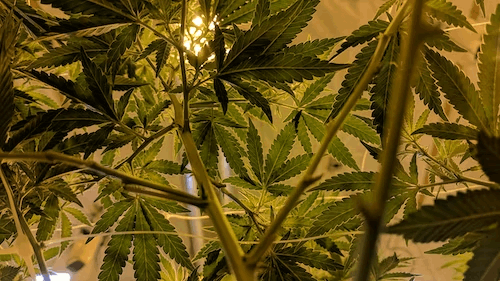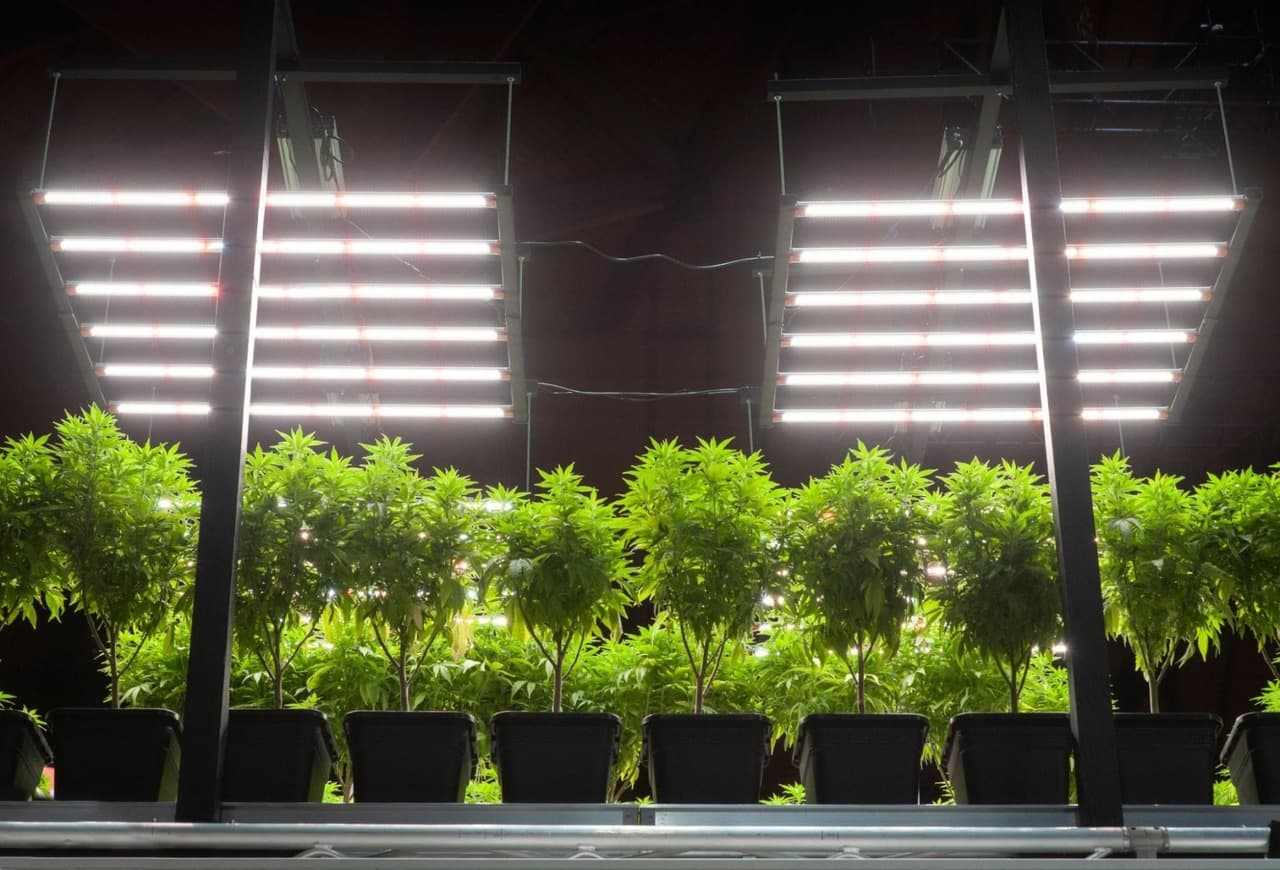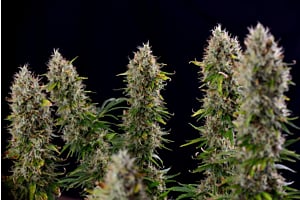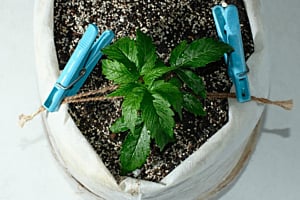Contents
How to control the flowering stretch
FAQs about cannabis flower stretching
Your cannabis crops have just finished vegging and suddenly experience a vertical growth spurt. Why? Is it normal? When do your plants stop stretching in flower?
This sudden growth is entirely normal and usually lasts for the first few weeks of blooming before bud development. Still, excessive stem growth can lead to structurally weak crops, lower-quality buds, and diminished yields; nobody wants that!
So how do you control the stretching during the blooming phase, and what other factors are at play? We’ve got all the answers you need for healthy, sturdy plants and the best possible harvests.
Ready? Let’s get started.
Why cannabis stretches

Just like humans experience rapid growth during adolescence, marijuana plants reach their ultimate height in a relatively short time. Different hormonal changes occur as they enter the flowering stage, triggering sudden stem growth.
How tall does a weed plant grow? Well, it depends on a few factors. While cannabis crops can stretch at other points in their lives, this initial blooming stage is the most significant for vertical growth.
Do you know how long the flowering stretch takes? After around 2–4 weeks, your weed plants should stop growing taller and instead focus their energy on producing buds.
It’s a normal part of a weed plant’s life cycle, but dramatic stem growth can still be detrimental. Left unchecked, it can reduce final yields by a whopping 20–30%. Several contributing factors exist, including genetics, the grow environment, and lighting.
Let’s take a closer look.
Grow environment
Environmental factors like temperature, lighting, and space can all cause abnormal or excessive flower stretching. Too much heat encourages cannabis plants to grow taller, resulting in lanky, unstable crops that could topple over.
Temperatures exceeding 80.6°F could cause aggressive stem growth, leading to weaker plants, smaller buds, and reduced yields. Light and dark hours are also significant factors.
A stark difference in day vs. night temperatures could promote gibberellin production, which increases stem stretching.
While space may be less of an issue outdoors, indoor cultivators might struggle with marijuana plants growing uncontrollably in a limited area. This, in itself, can lead to subpar harvests.
Stretching also occurs when a grow room (or garden) is overcrowded. Your weed plants will have no choice but to compete for light, water, and nutrients, resulting in frail, spindly stems and poor bud quality.
Light type
Red and orange-hued lights tend to promote cannabis stretching. Conversely, colder tones like blue, white, and yellow encourage larger stems and branches, which can help prevent excessive vertical growth.
Providing a strong light source throughout the seedling, vegging, and flowering stages is also vital. If you're cultivating a few weed crops with nothing but a 100W lamp, they could start stretching.
Anything below 50 and 70 watts per square foot may push your plants to grow as tall as possible.
Light distance
Light distance also matters. When cannabis plants are too far from a grow lamp or natural sunlight, they exert energy to find it. This results in dramatic stem growth.
Due to their remarkable adaptability, marijuana plants will extend upward in a bid to reach that all-important luminosity.
Unlike normal blooming stretch, this kind of growth is unhealthy and can substantially harm the plant's general well-being and bud production.
Genetics
Are your plants not stretching in the flowering phase? Don’t worry; this might be entirely normal. Genetics have an ultimate say on a cannabis plant's height, size, and development.
You can control your crop’s stretch to an extent, but the greatest determining factor is encoded in its DNA. Indica strains typically grow shorter and bushier compared to sativa cultivars, many of which can easily reach over 6 feet.
How to control cannabis flowering stretch

While the flowering stretch is normal for all cannabis plants, such vertical growth can be significant in some breeds and barely noticeable in others. If your strain grows more than expected, it helps to have a plan in place.
Preventing excessive stretching is vital for two main reasons. First, you don’t want your weed plant to become too tall and lose structural strength. Highly elastic crops can topple over before their buds have fully developed.
The branches may break, and the plant might never recover. Nothing is sadder than picking up a collapsed crop!
The second reason is yield and bud quality. Although tall plants look magnificent, too much vertical growth may negatively affect your harvest. The more energy they use to grow upward, the less energy they’ll spend on producing colas.
Space is another factor. A healthy crop stretching normally outdoors is less of an issue, but indoors, the size of a grow tent is limited. Many cultivators can’t accommodate massive plants within their walls.
Fortunately, you can learn how to stop the stretch in the flowering stage. Check out the helpful tips below.
Pick the right strain
Understanding the characteristics of your chosen cannabis strain is the first step to early stretch avoidance. As mentioned, some breeds are genetically predisposed to grow taller than others. That's why picking the right cultivar is crucial.
If you know what to expect, you can easily manage stem growth in your flowering weed plants. Choose strains that suit your growing environment.
Most indica strains have a short and bushy structure with dense flowers. Sativa cultivars are known to produce airy, elongated buds, but they’re notorious for growing tall and lanky.
There are always exceptions, though, so research your chosen strain beforehand to get a better idea of its average height.
Consider your grow environment too. Shorter hybrids or autoflowering strains might be a good choice if you have a limited indoor area. If you have a garden with more space where outdoor flowering stretch isn’t an issue, opt for taller plants.
To reduce the risk of undesirable genetic traits and unpredictable plant behavior, only use established and renowned vendors like SeedSupreme. We have hundreds of strains and only the highest-quality feminized, regular, and autoflower seeds for sale.
Consider the light type, temperature, and distance
Remember, the amount of light a plant receives influences its vertical growth. In nature, cannabis reaches toward the sun, like most plants. Reducing the distance between your lamps and marijuana crops can help minimize stretching.
Heat also affects your plants’ growth, so always monitor the temperature when growing indoors. Unnatural stem growth can occur when temps exceed around 80°F.
Creating a suitable climate can be challenging, even with the best lights for cannabis growing. Still, distance is a major factor. The type and strength of your bulbs help determine the appropriate proximity.
If you have fluorescent, metal halide (MH), or high-pressure sodium (HPS) lamps, you can conduct the ‘hand test.’ This trick ensures they’re close enough for maximum light exposure and minimal flower stretching without burning your weed plants.
Place a downward-facing palm over your crop to gauge the heat. If it’s uncomfortably hot or painful, move your bulbs an inch away and try again. If you have light-emitting diodes (LEDs) or light-emitting ceramics (LECs), keep them about 18–24 inches away from your plants.
Check the manufacturer’s specifications, too, as some bulbs may be stronger or weaker. Light output should be between 50 and 70 watts per square foot to prevent stretching.
Here are a few more noteworthy tips:
- HPS lamps may accelerate stretching. Opt for MH lights in the early flowering stages before switching to HPS ones later.
- Ceramic metal halide or LEC lights encourage stretching. You can flip your plants into flowering a little early to prevent excessive stem growth, though.
- If you’re using fluorescent lamps like CFLs or T5s, opt for 6,500K bulbs to promote lateral growth during the first few weeks of the 12/12 cycle. Switch to 2,700K lamps once natural stretching ceases.
- LEDs don’t typically encourage excessive vertical growth, but it depends on the model and make.
- Bear in mind that warmer, red-hued lights (regardless of type) mimic the fall and late summer sunlight, which can promote flower stretching. Cooler white-, yellow-, and blue-toned lamps can prevent it, as they encourage more lateral growth.
The simplest way to mitigate aberrant stretching is to provide sufficiently powerful light. Use lamps within the correct color spectrum, situated at the proper distance from the canopy.
Implement topping
Topping is a form of manual manipulation to improve cannabis plant yields, shape, or size. It’s a high-stress training (HST) technique that entails removing a fresh, actively developing node from your cannabis plant to mold it into a "v" shape.
Doing this eliminates apical dominance, so your plant produces two colas instead of one. Rather than growing upward, the crop directs its energies to develop more side branches, resulting in a shorter, bushier structure.
While topping can be an effective treatment for stretching, you shouldn't attempt it after flowering. Only try it when your plants are young and have 4–6 sets of leaves (nodes).
You could do it a bit earlier, but you may unintentionally stunt your crop’s growth.

Try manual stressing techniques
Most cannabis plants typically double in size during the first three weeks of flowering. As such, you may want to shorten the vegetative stage. Physical intervention is a more hands-on approach to help reduce over-stretching.
By manually bending marijuana leaves and stalks, you can create small tears to plant tissue, similar to the natural effect wind has on the crop. This stress forces the plants to channel their energy towards stem regeneration, reducing cannabis stretch.
You could also implement strategies like low-stress training (LST), the Sea of Green (SoG), and Screen of Green (ScrOG). These techniques help control the canopy’s height and enable all parts of the plant to receive sufficient light.
Low-stress training
LST involves training the stems and branches to grow horizontally instead of vertically. To prevent cannabis plants from growing upwards, many cultivators bend the branches throughout the growing cycle. This technique also maximizes space, especially indoors.
The easiest way to bend stems and branches is during the vegetative stage. Your marijuana plants are pliable and less likely to snap. Implementing LST while your weed crops are flowering can permanently damage your buds and overall yield.
You can fasten the branches to the side of the plant’s pot with strong wires or cable ties to withstand the branches' attempts to stand upright.
Sea of Green
The Sea of Green (SoG) is a popular technique that reduces cannabis stretching and increases yields in a limited space. Instead of having a few large plants, many small ones are cultivated in a compact area.
The marijuana crops grow closely together and form a canopy, giving the method its nickname, the ‘sea of green.’
The SoG trains weed plants to stay shorter, smaller, and bushier by forcing them to flower much earlier. This mitigates excessive stretching, allows for quicker harvests, and increases overall yields.
Screen of Green
While the SoG involves a greater number of smaller plants, the Screen of Green (ScrOG) is about using fewer crops that grow bigger. The technique encourages marijuana plants to get as big as they can during the vegetative stage while limiting vertical growth.
The ScrOG involves using a net or “screen” as a physical barrier to weave or tie down stems and branches, encouraging horizontal growth. During the blooming stage, the buds develop at the same controlled height.
This promotes an even canopy, which prevents excessive cannabis flowering stretch.

Control air circulation
Outdoor cannabis plants typically grow upright, firmly anchored in the soil, despite the occasionally erratic elements at work. Continuous yet gentle breezes strengthen the stems by creating microscopic breaks that gradually increase thickness and stiffness.
The stems become sturdier instead of extending upward, thereby reducing stretching. In a grow room or tent, air circulation also impacts vertical growth. Outdoor gardens can use ambient airflow, but interior cultivation methods require careful control.
Weed plants need sufficient space to flourish. In the long run, the sturdiness, strength, and height of your crops also depend on proper ventilation.
A canopy with adequate space helps maintain good air circulation, cool temperatures, and evenly distributed light. If your crops are crammed into a small area without sufficient airflow, they'll grow tall and spindly.
Space your marijuana plants out evenly and use oscillating fans to strengthen their stems and branches. This forces them to maintain a compact and sturdy structure that withstands the wind and curbs abnormal and flower stretching.
You don’t need an expensive indoor setup to achieve adequate air circulation. Working with what you have effectively can produce desirable results.
If you’re operating a small tent, one fan should suffice, but if your grow room is larger, you’ll need more. Ideally, you should have one fan facing skyward and one pointing sideways.
FAQs about cannabis flower stretching
Unlike cannabis seedling stretching, vertical expansion during flowering is entirely normal. Still, it helps knowing the difference between healthy and excessive stem growth. That’s why we’ve answered some common questions below.
When does cannabis start stretching?
Normally, cannabis plants start stretching the most during the first two weeks of flowering. Some strains may continue to do so until the third or even fourth week of flowering.
When does cannabis stop stretching?
Upon completing initial hormonal changes in the first 2–4 weeks of bloom, your cannabis plants should stop stretching in flower. At this point, the crop’s biochemical energy shifts focus from vertical stem growth to creating dense, resinous buds.
How can you tell if your cannabis plant is stretching?
Research your chosen strain beforehand to gauge its average height and know what kind of growth to expect. Frequent monitoring also helps. If the stem suddenly appears weak, spindly, and unusually tall, it may signify excessive stretching.

Embrace the flowering stretch
It's normal for cannabis plants to stretch throughout the early phases of flowering, though the extent differs depending on the strain. That’s why knowing the difference between healthy growth and radical stretching is vital.
Armed with the right knowledge, you can better control stem growth in the flowering stages to achieve bountiful harvests and superb quality buds.
Start with picking suitable strains for your cultivation environment and install the correct grow lights. You can also implement topping or other manual techniques to control plant stretching, but make sure your weed plants have adequate air circulation too.
These strategies can help your crops develop into the dense, thick, bud-laden bushes you’re aiming for.
Remember, the perfect plant begins with choosing the right seeds. Get high-quality cannabis seeds at our seedbank for desirable growth rates and final results. Best of luck on your next grow!

 THC
THC THCA Flower
THCA Flower







